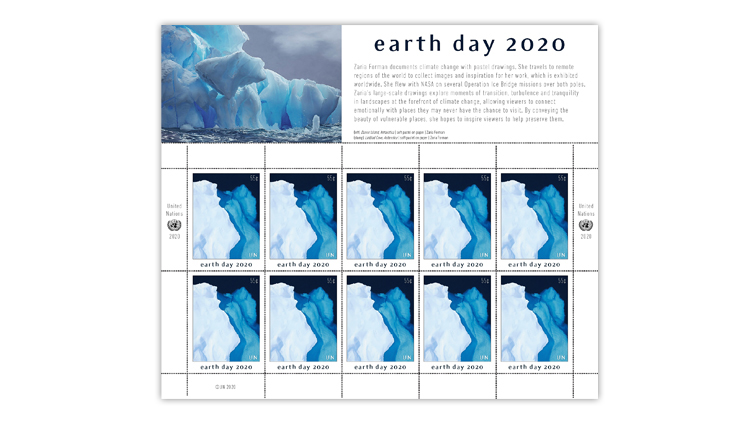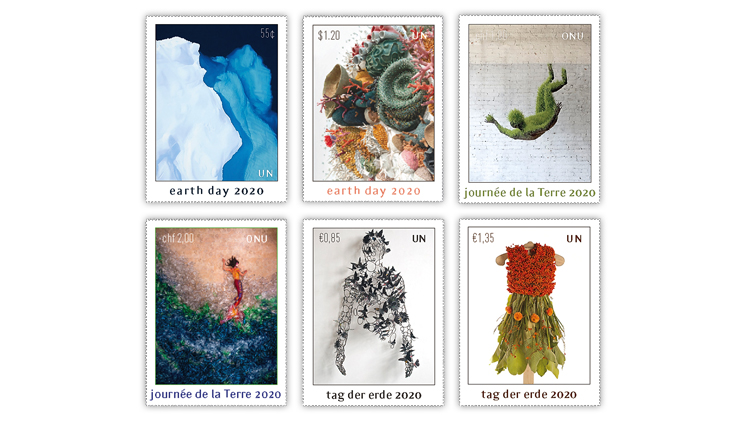World Stamps
U.N. Earth Day stamps feature environmental art
By Denise McCarty
The works of six different artists are represented on the United Nations Postal Administration’s new stamps celebrating Earth Day. The UNPA said that it selected artists “whose works are influenced by environmental issues.”
The six stamps were issued April 22 in separate panes of 10, with two panes for each U.N. post office: 55¢ and $1.20 for use from U.N. headquarters in New York City; 1 franc and 2fr for use from the Palais des Nations in Geneva, Switzerland; and €0.85 and €1.35 for use from the Vienna International Center in Vienna, Austria.
The first Earth Day was observed 50 years ago on April 22, 1970. Since then many countries have continued to celebrate Earth Day on April 22. In 2009 the U.N. General Assembly designated April 22 as International Mother Earth Day.
According to the U.N. website, “International Mother Earth Day is celebrated to remind each of us that the Earth and its ecosystems provide us with life and sustenance.
“This Day also recognizes a collective responsibility, as called for in the 1992 Rio Declaration, to promote harmony with nature and the Earth, to achieve a just balance among the economic, social and environmental needs of present and future generations of humanity.”
The 55¢ stamp features Zaria Forman’s pastel drawing of Linblad Cove in Antarctica. Her pastel drawing of Danco Island, Antarctica, is shown in the selvage of the pane in the upper left.
The selvage above the 10 stamps also includes the inscription “earth day 2020” followed by a brief description of Forman’s work in documenting climate change with her pastel drawings.
The other panes are similar in format with an image in the upper left and text on the right. The UNPA describes this text as “an artist’s statement describing how the planet and sustainability has inspired their work.”
Depicted on the $1.20 stamp is Our Changing Seas IV by Courtney Mattison. This glazed stoneware and porcelain sculpture also is shown in the selvage. In the text in the selvage, Mattison describes herself as “a ceramic sculptor with a background in coral reef conservation biology.”
Both Forman and Mattison are from the United States.
Terre (Earth) by French artist Mathilde Roussel is pictured on the 1fr stamp and in the image in the selvage. This sculpture which shows a human body in a free fall was made of earth, wheat seeds, recycled metal structure, fabric and cotton thread, according to an inscription on the pane.
The sculpture is part of a series called Lives of Grass, The contemporary art project website said that these sculptures “show the effects of transformation of the material as a metaphor of the transformation of the body. Time sculpts the forms, makes them change and then decay.”
The 2fr stamp depicts Mermaids Hate Plastic by Canadian artist and photographer Benjamin Von Wong. He combined photography and 10,000 bottles borrowed from the Tomra waste management center to create the image, according to his blog. The purpose of this artwork is to encourage people to reduce their use of plastic.
For more than three decades, American artist Paul Villinski has been creating works of art from discarded materials, many of them with butterfly themes. Featured on the €0.85 stamp is his Lepidopterist, 2017. Constructed using found aluminum cans, steel and soot, it shows butterflies on the head and torso of a butterfly specialist.
The €1.35 stamp pictures a compostable dress made from leaves, flowers, berries, thorns. Canadian environmental artist Nicole Dextras created it as part of her Little Green Dress project for the Earth Art exhibition at VanDusen Botanical Garden in Vancouver, British Columbia, Canada.
Dextras fashioned 21 dresses for this project, and a composite photograph of them is shown in the selvage. The dress depicted on the stamp was made for a woman named Ruth, using plant materials from her garden.
Rorie Katz designed the stamps and panes. The printing office of France’s La Poste printed them by offset plus hexachrome, according to UNPA.
The panes are 170 millimeters by 146mm, and the stamps are 30mm by 40mm, perforated gauge 13 by 13. The printing quantities are 12,000 each of the 55¢ and $1.20 panes; 9,000 each of the 1fr and 2fr panes; and 10,000 each of the €0.85 and €1.35 panes.
For ordering information, visit the UNPA website; email unpanyinquiries@un.org; telephone 212-963-7684 or 800-234-8672; or write to UNPA, Box 5900, Grand Central Station, New York, NY 10163-5900.
The UNPA has posted the following notice on its website: “Important information and alert: Please note that your orders and/or mail may be impacted or delayed due to the restrictions at the United Nations Headquarters and the United Nations office in Vienna as a result of the COVID-19 outbreak. We are, however, committed to process and fulfill your orders as soon as we can. If there’s any question, please email us at unpanyinquiries@un.org or UNPA-Europe@un.org or UNPA-ASIA@un.org. Thank you for your patience and understanding.”
Connect with Linn’s Stamp News:
Sign up for our newsletter
Like us on Facebook
Follow us on Twitter
MORE RELATED ARTICLES
Headlines
-
US Stamps
Oct 7, 2024, 3 PMMcMurtrie dismissed as APS education director following Sept. 21 arrest
-
US Stamps
Oct 7, 2024, 12 PMVasiliauskas named president of Mystic Stamp Co.
-
US Stamps
Oct 6, 2024, 5 PMApgar souvenir card available
-
US Stamps
Oct 6, 2024, 4 PMFirst Continental Congress and U.N. stamps receive Scott catalog numbers










